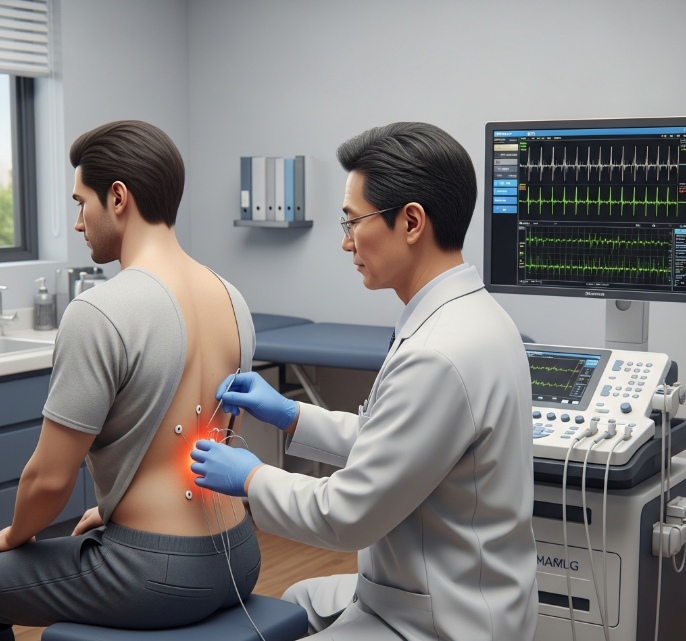Are you tired of back pain dictating your life? Do you find yourself constantly searching for solutions that offer gen-
uine, lasting relief? You're not alone. Millions experience the frustration of back pain, often without understanding
the root cause. This blog post delves into the often-overlooked connection between muscle imbalances and back
pain, and how Electromyography (EMG) – a powerful diagnostic tool used by physiotherapists – can help you
reclaim your spinal health.
Muscle Imbalances & Back Pain: The Unseen Connection
Back pain often stems from muscle imbalances – a situation where some muscles overwork while others
weaken. This imbalance disrupts the natural mechanics of your spine, leading to pain, stiffness, and reduced
mobility. Muscle imbalances are a common cause of back pain, frequently arising from overuse, poor posture, or
inadequate training. Think of your back muscles as a team; when some team members are pulling more than their
weight, and others are slacking off, the entire structure becomes unstable. This instability can lead to excessive
stress on certain areas of your spine, resulting in pain and discomfort.
Poor posture, repetitive movements, lack of exercise, and even past injuries can all contribute to these imbalances.
Over time, these factors can lead to a cascade of problems, making everyday activities challenging and impacting
your overall quality of life.
EMG Assessment for Back Pain: Physiotherapy's Diagnostic
Tool
Electromyography (EMG) is a powerful diagnostic technique – a window into your muscles – that allows us to
see exactly how they're functioning. Within physiotherapy, it's a valuable tool for assessing muscle function. It's
like taking a detailed look at how your muscles are firing and working together. This information is invaluable in
identifying muscle imbalances that contribute to back pain. During an EMG assessment, small sensors are placed
on the skin over specific muscles in your back. These sensors pick up the tiny electrical signals your muscles
produce when you move. The data is then displayed on a screen, allowing the physiotherapist to analyze muscle
activation patterns and identify any abnormalities.
Muscle recruitment varies based on the activity performed. Lifting a lighter weight involves fewer muscles, while
lifting a heavier weight requires more muscles to generate force. As force increases, the central nervous system
becomes more stimulated, activating additional motor units and increasing their firing rate. This leads to larger
EMG signal amplitudes, indicating heightened muscle activity. By using electromyography, we may exert force,
make movements, and perform many other actions that let us engage with the environment. The electromyograph
is a bioelectric signal that has a wide range of uses that have grown over time. Neurological problems are typically
diagnosed using electromyography in clinical settings. It is widely used to evaluate individuals with neuromuscular
illnesses, lower back pain, and motor control abnormalities.
Decoding Muscle Activity: EMG Reveals the Root of Back Pain
EMG shows us exactly how your muscles are functioning. It pinpoints which muscles are overactive, underactive,
or not firing in the correct sequence. For example, in individuals with chronic low back pain, EMG can help
identify weakened core muscles or overactive paraspinal muscles. EMG is widely used to evaluate individuals with
neuromuscular illnesses, lower back pain, and motor control abnormalities.
By understanding these muscle activation patterns, your physiotherapist can pinpoint the specific imbalances
that are contributing to your pain. This allows for a more targeted and effective approach to treatment, rather than
simply addressing the symptoms.
Personalized Physiotherapy: EMG-Guided Treatment for Lasting
Relief
Physiotherapist can develop a tailored rehabilitation program designed to correct your specific muscle imbalances.
This may involve a combination of exercises, manual therapy, and other techniques.
For example, if EMG reveals that your core muscles are weak, your treatment plan may include specific exercises
to strengthen these muscles and improve spinal stability. If certain muscles are overactive, your physiotherapist
may use techniques to release tension and restore proper muscle function. This personalized approach ensures
that you receive the most effective treatment for your individual needs.
Core Muscle Strengthening for Back Pain Relief
Your core muscles – think of your abs and back muscles – are like the foundation of your spine, helping you stand
tall and move with ease. Core muscle strengthening is often a key component of physiotherapy treatment for back
pain related to muscle imbalances. When these muscles are weak, it can lead to increased stress on your back
and contribute to pain. EMG can be used to monitor the effectiveness of core strengthening exercises and ensure
that you are activating the correct muscles. Furthermore, EMG biofeedback-assisted trunk stabilization exercises
may improve trunk muscle activity, strength, proprioception, and balance control in patients with CLBP.
Strengthening your core is a crucial step in restoring balance and stability to your spine, helping you move with
greater ease and confidence.
Conclusion
If you're struggling with persistent back pain, muscle imbalances could be the culprit. EMG offers a powerful
tool for identifying these imbalances and guiding personalized physiotherapy treatment. By understanding how
your muscles are functioning, your physiotherapist can develop a targeted rehabilitation program to correct
imbalances, reduce pain, and improve your overall function. Ready to unlock the secret to a pain-free back?
Consult with a qualified physiotherapist to see if EMG is right for you. Don't let muscle imbalances sabotage your
back any longer! Transforming physiotherapy, one patient at a time.
